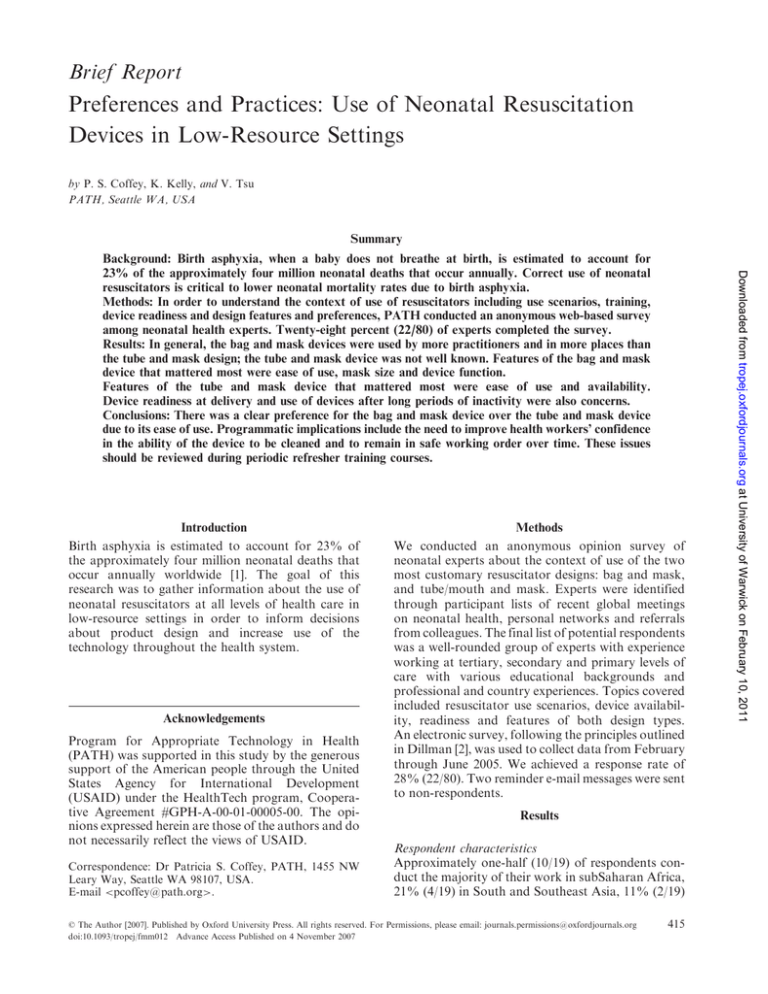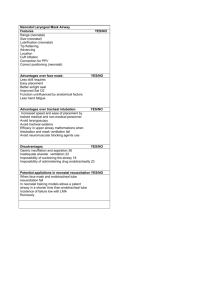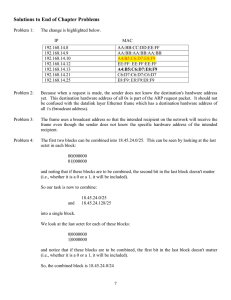
Brief Report
Preferences and Practices: Use of Neonatal Resuscitation
Devices in Low-Resource Settings
by P. S. Coffey, K. Kelly, and V. Tsu
PATH, Seattle WA, USA
Summary
Introduction
Birth asphyxia is estimated to account for 23% of
the approximately four million neonatal deaths that
occur annually worldwide [1]. The goal of this
research was to gather information about the use of
neonatal resuscitators at all levels of health care in
low-resource settings in order to inform decisions
about product design and increase use of the
technology throughout the health system.
Acknowledgements
Program for Appropriate Technology in Health
(PATH) was supported in this study by the generous
support of the American people through the United
States Agency for International Development
(USAID) under the HealthTech program, Cooperative Agreement #GPH-A-00-01-00005-00. The opinions expressed herein are those of the authors and do
not necessarily reflect the views of USAID.
Correspondence: Dr Patricia S. Coffey, PATH, 1455 NW
Leary Way, Seattle WA 98107, USA.
E-mail <pcoffey@path.org>.
Methods
We conducted an anonymous opinion survey of
neonatal experts about the context of use of the two
most customary resuscitator designs: bag and mask,
and tube/mouth and mask. Experts were identified
through participant lists of recent global meetings
on neonatal health, personal networks and referrals
from colleagues. The final list of potential respondents
was a well-rounded group of experts with experience
working at tertiary, secondary and primary levels of
care with various educational backgrounds and
professional and country experiences. Topics covered
included resuscitator use scenarios, device availability, readiness and features of both design types.
An electronic survey, following the principles outlined
in Dillman [2], was used to collect data from February
through June 2005. We achieved a response rate of
28% (22/80). Two reminder e-mail messages were sent
to non-respondents.
Results
Respondent characteristics
Approximately one-half (10/19) of respondents conduct the majority of their work in subSaharan Africa,
21% (4/19) in South and Southeast Asia, 11% (2/19)
ß The Author [2007]. Published by Oxford University Press. All rights reserved. For Permissions, please email: journals.permissions@oxfordjournals.org
doi:10.1093/tropej/fmm012 Advance Access Published on 4 November 2007
415
Downloaded from tropej.oxfordjournals.org at University of Warwick on February 10, 2011
Background: Birth asphyxia, when a baby does not breathe at birth, is estimated to account for
23% of the approximately four million neonatal deaths that occur annually. Correct use of neonatal
resuscitators is critical to lower neonatal mortality rates due to birth asphyxia.
Methods: In order to understand the context of use of resuscitators including use scenarios, training,
device readiness and design features and preferences, PATH conducted an anonymous web-based survey
among neonatal health experts. Twenty-eight percent (22/80) of experts completed the survey.
Results: In general, the bag and mask devices were used by more practitioners and in more places than
the tube and mask design; the tube and mask device was not well known. Features of the bag and mask
device that mattered most were ease of use, mask size and device function.
Features of the tube and mask device that mattered most were ease of use and availability.
Device readiness at delivery and use of devices after long periods of inactivity were also concerns.
Conclusions: There was a clear preference for the bag and mask device over the tube and mask device
due to its ease of use. Programmatic implications include the need to improve health workers’ confidence
in the ability of the device to be cleaned and to remain in safe working order over time. These issues
should be reviewed during periodic refresher training courses.
BRIEF REPORT
TABLE 1
Frequency of use of neonatal resuscitator devices in developing countries, as observed by respondents
Respondents
Never
number (%)
0
0
0
1/20 (5)
2/18 (11)
12/14 (86)
0
1/21
1/20
3/20
1/18
2/14
(5)
(5)
(15)
(6)
(14)
2/21
2/21
1/20
1/20
2/18
0
(10)
(10)
(5)
(5)
(11)
2/21
4/21
8/20
6/20
4/18
0
(10)
(19)
(40)
(30)
(22)
17/21
14/21
10/20
9/20
9/18
0
(81)
(67)
(50)
(45)
(50)
4/17
5/18
5/18
13/15
7/15
12/17
6/17
4/18
2/18
1/15
2/15
3/17
(35)
(22)
(11)
(7)
(13)
(18)
1/17
3/18
3/18
0
4/15
1/17
(6)
(17)
(17)
1/17
0
3/18
0
1/15
1/17
(6)
5/17
6/18
5/18
1/15
1/15
0
(29)
(33)
(28)
(7)
(7)
(24)
(28)
(28)
(87)
(47)
(71)
(27)
(6)
(17)
(7)
(6)
TABLE 2
Neonatal resuscitators currently in use by health workers attending births in developing countries
Resuscitators
Bag and mask
Tube and mask
Other
Tertiary care facility
number (%)
Secondary care facility
number (%)
Primary care facility
number (%)
In the home
number (%)
19/21 (90)
4/11 (36)
3/8 (38)
20/21 (95)
2/11 (18)
2/8 (25)
13/21 (62)
6/11 (55)
7/8 (88)
4/21 (19)
5/11 (45)
5/8 (63)
in North America/Europe and 11% (2/19) work
globally. Seventy-four percent (14/19) of respondents
currently work as medical doctors, 11% (2/19) as
nurses and 16% (3/19) as midwives. No information
is available about non-respondents due to the
anonymous nature of the survey.
Scenarios of use
Eighteen out of twenty-one (86%) respondents
reported that they had used a neonatal resuscitator
device in a developing country. Respondents
reported that the most common scenario of use
(at least once a month) occurred with medical
doctors in tertiary facilities (81%) (Table 1).
In contrast, scenarios reported as never observed
by respondents were use by traditional birth
attendants (TBA) in primary care facilities (87%),
followed by TBA use in secondary care facilities
(86%) and during home births (71%).
Device availability
Bag and mask devices were cited much more
frequently than tube and mask as the type of
resuscitator currently being used by health workers
attending births, especially at higher levels of care
(Table 2). When no resuscitator device was available,
416
mouth-to-mouth resuscitation with a gauze barrier
was used most commonly.
Device preference
Ease of use was the feature that mattered most to
those who had experience using either kind of device.
Size of the mask and overall device function were
noted as key features by respondents who had
experience using bag and mask devices, and availability was noted as a key feature by respondents
with experience using tube and mask devices.
Respondents reported a clear preference for the
bag and mask device over the tube and mask device,
(Table 3) due to its ease of use. The tube and mask
design was preferred for its simplicity and portability.
The tube and mask device was cited as difficult
to use because it requires the user to constantly
bend forward and blow 30–40 times per minute,
the infant is not visible during resuscitation, and it
is difficult to tell if the pressure being used is
appropriate.
Device readiness, ease of cleaning and storage
Forty-two percent (8/19) of respondents said that a
resuscitation device was ready and available for all
deliveries, while 16% (3/19) said it was ready only
Journal of Tropical Pediatrics
Vol. 53, No. 6
Downloaded from tropej.oxfordjournals.org at University of Warwick on February 10, 2011
Medical doctors in tertiary care facility
Nurses in tertiary care facility
Medical doctors in secondary care facility
Nurses in secondary care facility
Midwives in secondary care facility
Traditional birth attendants
(TBAs) in secondary care facility
Medical doctors in primary care facility
Nurses in primary care facility
Midwives in primary care facility
TBAs in primary care facility
Midwives at home birth
TBAs at home birth
Rarely
Somewhat
Common
Very common
(less than 1
common
(at least 1
(at least 1
time/year) (1–3 times/year) time/quarter) time/month)
number (%)
number (%)
number (%)
number (%)
BRIEF REPORT
TABLE 3
Questions and answers on survey regarding bag and mask versus tube and mask
Questions
Bag and mask
number (%)
Tube and mask
number (%)
Downloaded from tropej.oxfordjournals.org at University of Warwick on February 10, 2011
4/19b (21)
Number of respondents with experience using the device.
20/21a (95)
How many newborns have you effectively resuscitated with each device?
None
0
1/4 (25)
1–4 newborns
0
2/4 (50)
5–20 newborns
3/19 (16)
0
21 or more newborns
13/19 (68)
0
Other
4/19 (21)
1/4 (25)c
How many newborns have you seen other health care workers resuscitate effectively with each device?
None
0
1/4 (25)
1–4 newborns
0
1/4 (25)
5–20 newborns
2/19 (11)
1/4 (25)
21 or more newborns
13/19 (68)
0
Other
4/19 (21)
1/4 (25)
Overall is the device easy to use for newborn resuscitation?
Yes
20/20 (100)
2/4 (50)
Is the device easy to assemble and disassemble for cleaning without written instructions?
Yes
14/18 (78)
3/3 (100)
What features make it easy to use?
Clear instructions/easy to read
10/19 (53)
2/4 (50)
Pictures for non-literate populations
8/19 (42)
3/4 (75)
Few parts to assemble
15/19 (79)
4/4 (100)
Easy to clean
11/19 (58)
2/4 (50)
Other
4/19 (21)
2/4 (50)
What features make it difficult to use?
Instructions are difficult to read
5/14 (36)
1/4 (25)
No instructions for non-literate populations
6/14 (43)
1/4 (25)
Too many parts to assemble
6/14 (43)
0
Difficult to clean
8/14 (57)
0
Tiring to use for more than a few minutes
5/14 (36)
3/4 (75)
Other
2/14 (14)
3/4 (75)
Is it easy to train someone how to use this device?
Yes
17/19 (90)
3/4 (75)
Is the face mask provided usually the appropriate size for most newborns?
Yes
9/19 (47)
2/4 (50)
Is the device easy to clean?
Yes
12/18 (67)
3/3 (100)
After cleaning the device are you confident that any/all bacteria and microbes
have been removed and that it has not been damaged due to the cleaning process?
Yes
7/18 (39)
1/3 (33)
Is the device easy to store?
Yes
18/18 (100)
3/3 (100)
How long are these devices able to remain in good working condition?
Less than 1 year
3/17 (18)
0
1–5 years
12/17 (71)
4/4 (100)
More than 5 years
2/17 (12)
0
Is the device easily accessible/easy to find when needed?
Yes
14/17 (82)
3/3 (100)
Do you have confidence that after long periods of non-use, a previously used,
cleaned, and stored device will work adequately?
Yes
11/18 (61)
2/3 (67)
Do you have confidence that after long periods of non-use, a previously used,
cleaned and stored device is safe during use?
Yes
10/18 (56)
3/3 (100)
In your opinion, can health workers use the device easily and safely, without any
refresher training, after long periods of non-use?
Yes
7/17 (41)
1/2 (50)
(continued)
Journal of Tropical Pediatrics
Vol. 53, No. 6
417
BRIEF REPORT
TABLE 3
Continued
Questions
Bag and mask
number (%)
Tube and mask
number (%)
Which features matter most to you when forming
your overall opinion about the device?
Bag: 10/18 (56)
Tube:
3/4 (75)
Mouthpiece: 2/4 (50)
Mask: 2/4 (50)
Valve: 2/4 (50)
0
In general, which device do you prefer?
Mask: 12/18 (67)
Valve: 7/18 (39)
Other: 3/18 (17)
17/19 (90)
when a complication was anticipated. Most respondents reported that device accessibility depended
heavily on where it was stored.
Respondents considered the bag and mask device
difficult to clean due to difficulty in accessing the
inner part of the device. One respondent noted
that it was difficult to properly clean the tube of
the tube and mask design and that the design allows
some residue to remain inside the tube, even after
cleaning.
After long periods of non-use, previously used,
cleaned and stored devices may not be entirely
ready for use. The majority of respondents recommended checking and even cleaning the device if
it had not been used for long periods of time.
The need for frequent refresher trainings was
stressed to ensure safe and effective use of either
device.
Discussion
This study was not designed to be representative and
is therefore subject to self-selection bias. It also
included a limited number of practitioners with
experience using the tube and mask design.
This investigation, however, yielded important
information regarding practices related to device
use in low-resource settings and the positive and
negative aspects of device designs. In general, bag
and mask devices were used by more practitioners
and in more places than the tube and mask design.
This is consistent with the relatively limited literature
that documents the use of tube and mask designs in
low-resource settings [3, 4].
418
Although laboratory testing of various resuscitator
designs has been conducted in a limited fashion [5–7],
these findings represent the first time that devicespecific information about preferences and practices
has been reported. Strengthening the supply of
neonatal services has been identified as an essential
ingredient to systematic global scale-up of neonatal
care [8]. Strengthening supply requires a detailed
understanding of preferences and practices related to
specific equipment being used. This study offers
information that is useful not only to product
development teams but also to program planners
who are interested in addressing some of the
equipment issues related to the provision of neonatal
care in low-resource settings. Programmatic implications include the need to improve health workers’
confidence in the ability of the device to be cleaned
and to remain in safe working order over time. These
issues should be reviewed during periodic refresher
training courses.
References
1. Lawn J, Cousens S, Zupan J, et al. Lancet Neonatal
Survival Steering Team. 4 million neonatal deaths:
When? Where? Why? Lancet 2005;365:891–900.
2. Dillman D. Mail and Internet Surveys: The Tailored
Design Method. New York: John Wiley Company, 1999.
3. Ariawan I, Agustini M, Seamans Y, et al. Choosing the
appropriate neonatal resuscitation device for village
midwives. Presented at: Asia Pacific Academic
Consortium of Public Health Conference, December
1–3, 2004; Brisbane, Australia.
Journal of Tropical Pediatrics
Vol. 53, No. 6
Downloaded from tropej.oxfordjournals.org at University of Warwick on February 10, 2011
Note: Because not all those surveyed answered each question, the percentages and number of respondents indicated are
not consistent from question to question. Percentages are based on the number of respondents answering each question.
a
One respondent skipped this question while 21 respondents answered this question. One noted he/she had not used
this device before and thus was not allowed to answer any further questions related to the bag and mask device in this
section. The denominators indicate the number of people who responded to that question. Respondents were allowed to skip
questions in this section. If a respondent skipped the question, his/her responses were excluded from the analysis and
subtracted from the denominator of total respondents for that question.
b
Three respondents skipped this question while 19 respondents answered this question. Fifteen respondents noted they
had not used this device before and thus were not allowed to answer any further questions related to the tube and
mask device in this section. The denominators indicate the number of people who responded to that question. Respondents
were allowed to skip questions in this section. If a respondent skipped a question, his/her responses were excluded from the
analysis and subtracted from the denominator of total respondents for that question.
c
Answers included ‘hundreds’ and ‘30 years experience with thousands of infants’.
BRIEF REPORT
4. Bang AT, Baitule RA, Reddy HM, et al. Management
of birth asphyxia in home deliveries in rural
Gadchiroli:
the
effect
of
two
types
of
birth attendants and of resuscitating with mouthto-mouth, tube-mask, or bag-mask. J Perinatol 2005;
25:S82–S91.
5. O’Donnell CP, Davis PG, Lau R, et al. Neonatal
resuscitation 2: an evaluation of manual ventilation
devices and face masks. Arch Dis Child. Fetal Neonatal
Ed 2005;90:F392–396.
6. Milner AD, Stokes GM, Tunell R, et al. Laboratory
assessment of Laerdal mouth tube mask prototype
resuscitation device. Med Biol Eng Comput
1992;30:117–119.
7. Anonymous. Evaluation: manually operated infant
resuscitators. Health Devices 1973;2:240–248.
8. Knippenberg R, Lawn J, Darmstadt G, et al. Lancet
Neonatal Survival Steering Team. Systematic scaling
up of neonatal care in countries. Lancet. 2005;
365:1087–1098.
Downloaded from tropej.oxfordjournals.org at University of Warwick on February 10, 2011
Journal of Tropical Pediatrics
Vol. 53, No. 6
419






